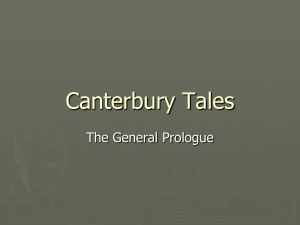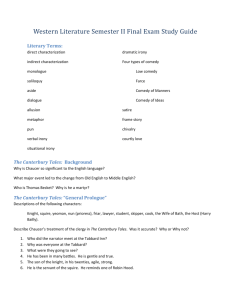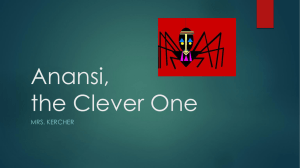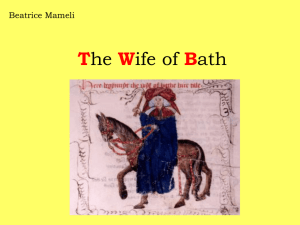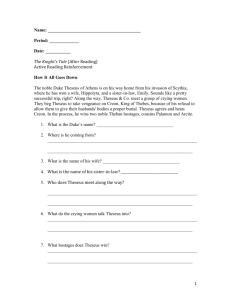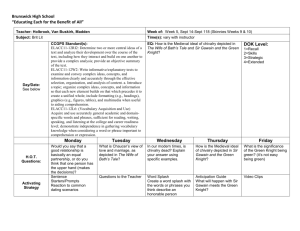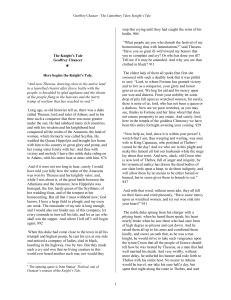Sample 3 - Department of English
advertisement
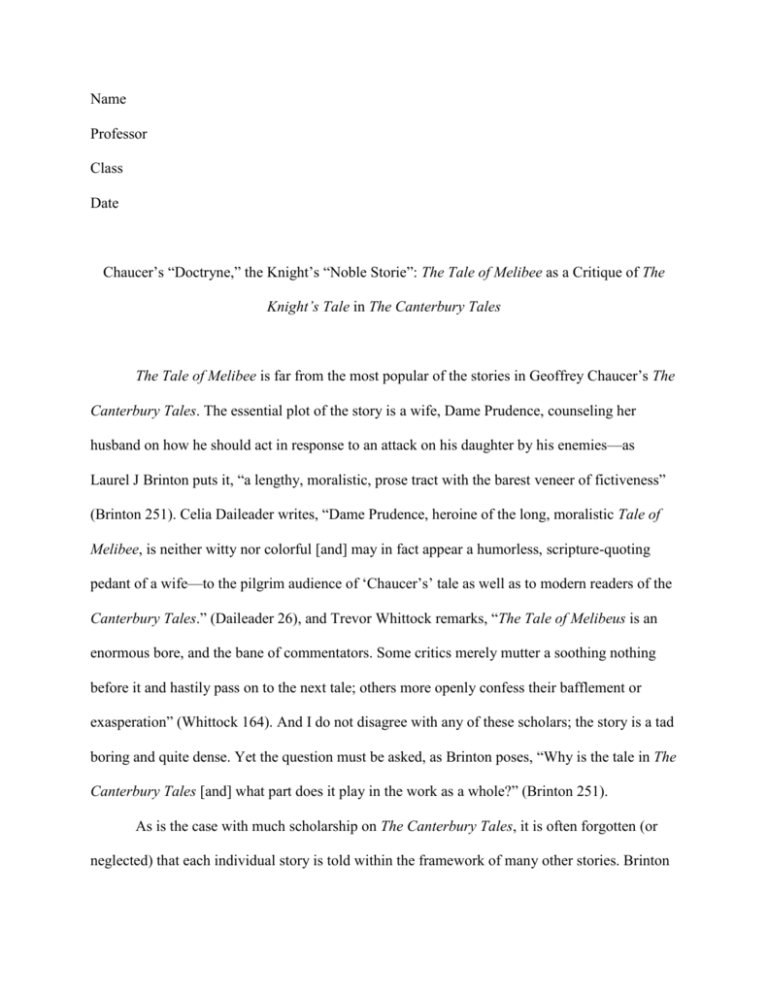
Name Professor Class Date Chaucer’s “Doctryne,” the Knight’s “Noble Storie”: The Tale of Melibee as a Critique of The Knight’s Tale in The Canterbury Tales The Tale of Melibee is far from the most popular of the stories in Geoffrey Chaucer’s The Canterbury Tales. The essential plot of the story is a wife, Dame Prudence, counseling her husband on how he should act in response to an attack on his daughter by his enemies—as Laurel J Brinton puts it, “a lengthy, moralistic, prose tract with the barest veneer of fictiveness” (Brinton 251). Celia Daileader writes, “Dame Prudence, heroine of the long, moralistic Tale of Melibee, is neither witty nor colorful [and] may in fact appear a humorless, scripture-quoting pedant of a wife—to the pilgrim audience of ‘Chaucer’s’ tale as well as to modern readers of the Canterbury Tales.” (Daileader 26), and Trevor Whittock remarks, “The Tale of Melibeus is an enormous bore, and the bane of commentators. Some critics merely mutter a soothing nothing before it and hastily pass on to the next tale; others more openly confess their bafflement or exasperation” (Whittock 164). And I do not disagree with any of these scholars; the story is a tad boring and quite dense. Yet the question must be asked, as Brinton poses, “Why is the tale in The Canterbury Tales [and] what part does it play in the work as a whole?” (Brinton 251). As is the case with much scholarship on The Canterbury Tales, it is often forgotten (or neglected) that each individual story is told within the framework of many other stories. Brinton Name 2 notes, “Criticism has generally been limited…to establishing the date of composition of the tale or seeing its relationship with its source” (Brinton 251). We cannot, however, deny or exclude the value of each tale as it relates to the others, and this is especially the case with The Tale of Melibee. Helen Cooper notes that the distinction Chaucer-the-pilgrim makes in the prologue to the tale—the distinction between “sentence” and verbal expression—is “an approximation to literary criticism” (Cooper 310). Though she notes that reading Chaucer as a literary critic based on this distinction is the wrong point to make, the idea of Chaucer as a critic is still one that I find to have merit. While Brinton and I agree on the point that The Tale of Melibee must be read as a part of the larger Canterbury Tales in order to fully understand the significance of the story, I fail to find his argument—that The Tale of Melibee is meant to answer the question “How can one successfully order one’s life?” (Brinton 254) in the Tales—to be compelling and thus propose an alternative theory. The premise of The Canterbury Tales is a storytelling competition between the pilgrims. The winner, according to the Host, who accompanies the group on their pilgrimage, is the pilgrim who can tell the best tale—that is, the tale with the best “sentence” (intrinsic moral value) and “solaas” (best entertainment value). Walter Scheps reminds us of the importance of this context when he writes, “Of the many problems in The Canterbury Tales, that which the pilgrims themselves, as well perhaps as Chaucer’s audience, would have found of the most immediate interest has been universally ignored. I refer, of course, to the designation of the best tale by the Host” (Scheps 113). The characters therein, then, would naturally be vying to claim the title of “winner” and would thus desire to not only tell the best tale but also to discredit the value of the tales which have already been told. Name 3 Chaucer-the-pilgrim’s first tale, The Tale of Sir Thopas, is a tale of chivalry and romance very much like The Knight’s Tale; in the prologue to Sir Thopas, Chaucer-the-pilgrim states, “Now holde youre mouth, par charitee / … And herkneth to my spelle; / Of batailles and of chivalry” (201, 203-204). While The Knight’s Tale is agreed to be a “noble storie” (3) by all the pilgrims, however, The Tale of Sir Thopas is interrupted by the Host, who voices his disapproval of the story and asks for a better one: “Lat se wher thou kanst tellen aught in geeste, / Or telle in prose somwhat, at the leeste, / In which ther be som mirthe or som doctrine” (Thopas 243-245). Helen Cooper correctly notes that the tale which follows, Chaucer-the-pilgrim’s Tale of Melibee, is in response to this interruption and disapproval by the host. In this essay, I argue that the Tale of Melibee, which is told in response to the Host declaring The Tale of Sir Thopas to be “vulgar foolishness” (231) and which Chaucer-thepilgrim holds to have true “sentence”—Chaucer-the-pilgrim qualifies the story as “a moral tale virtuous” (250)—is meant to critique The Knight’s Tale. In reading Chaucer-the-pilgrim through Dame Prudence, his leading character in The Tale of Melibee, we can see that the examples of good “sentence” portrayed in the tale are meant to expose how The Knight’s Tale violates these tenets of good value. Thus Chaucer-the-pilgrim also demonstrates how The Knight’s Tale should not be such a “noble storie” if his own chivalric Tale of Sir Thopas is valued as foolishness. The Tale of Melibee is a very structured tale, wherein Dame Prudence’s counsel to her husband addresses multiple arguments in turn. As such, I will start with Dame Prudence’s discourse on excessive grief—the first of the topics she addresses—and move through the themes of her argument one by one. I will draw connections between The Tale of Melibee and The Knight’s Tale in order to demonstrate how Chaucer-the-pilgrim’s tale functions as a critique of the “sentence” of the stories which are told before it. Name 4 Chaucer-the-pilgrim’s The Tale of Melibee begins with Melibee’s foes breaking into his house to attack his wife and daughter. The tale that follows has little true plot, save for Melibee’s wife Dame Prudence’s counseling to her husband with regards to what course of action he should take in response to this attack. Her first piece of advice concerns how one should act in displaying sorrow and grief. She explains Melibee that he should refrain from excessive grief: “This noble wyf Prudence suffred hir housbonde for to wepe and crie as for a certein space; and whan she saugh hir tyme, she seyde hym in this wise: ‘Allas, my lord,’ quod she, ‘why make ye youreself for to lyk a fool? For sothe it aperteneth nat to a wys man to maken swich a sorwe’” (2169-2171). Here she claims that a wise man would not allow himself to be in sorrow to the extent that Melibee is, and thus she is condemning him for maintaining his sorrowful state. She, after her husband asks why he should not be allowed to weep for his wounded child, adds: Wel I woot attempree wepyng is no thyng deffended to hym that sorweful is, amonges folk in sorwe, but it is rather graunted hym to wepe. The apostle Paul unto the Romayns writeth, ‘Man shal rejoyse with hem that maken joye, and wepen with swich folk as wepen.’ But though attempree wepyng be ygraunted, outrageous wepyng certes is deffended. (2178-2180) Here Prudence concedes that some weeping is acceptable, yet “outrageous” (i.e. excessive) sorrow is a fault. Yet such sorrow does make an appearance in The Knight’s Tale. As Candace Lines observes, “The Knight's Tale works within a literary tradition in which, as Lee Patterson1 puts it, ‘chivalry habitually represent[s] itself in sorrowful, even tragic terms’” (Lines n.p.). The Knight shows Palomon and Arcite, the two main characters of The Knight’s Tale, in excessive sorrow on multiple occasions throughout his tale. In fact, Ian Robinson has notes the extent of this when he notes “Palamon and Arcite’s determination to be miserable” in speaking Name 5 of The Knight’s Tale (Robinson 125). Upon departing from Athens under penalty of death should he return, Arcite succumbs to excessive grief over the fact that, though he is free, he will never be able to see Emily again: How greet a sorwe suffreth now Arcite! The deeth he feeleth thurgh his herte smyte, He wepeth, wayleth, crieth pitously, To sleen hymself he waiteth prively. Arcite further laments his woe when he cries, “Allas, that evere knew I Perotheus! / …Thanne hadde I been in blisse, and nat in wo” (369, 372), and: But I, that am exiled and bareyne Of alle grace, and in so greet dispeir That ther nys erthe, water, fir, ne eir, Ne creature, that of hem maked is, That may me helpe or doon confort in this, Wel oughte I sterve in wanhope and distresse, Farwel, my lif, my lust, and my gladnesse! (386-392) The Knight also states, “So muche sorwe hadde nevere creature, / That is, or shal whil that the world may dure” (501-502); Arcite spends his night wailing in sorrow, he weeps whenever he heas music, he never eats, and keeps company with no one but himself. It is obvious, then, that Arcite is partaking in “outrageous” sorrow. The Knight tells us explicitly that he suffered great sorrow and that he wept, wailed, cried, and thought of killing himself, while Arcite himself claims that nothing on earth will be able to reconcile his grief: “I Name 6 nam but deed, ther nys no remedye” (416). Arcite is so overcome by sorrow that he neglects the care for himself and physically wastes away. The Knight tells us that Palomon, too, is guilty of excessive sorrow in much the same way. When Arcite is released from prison at the behest of Perotheus and Palamon must remain, the Knight tells us that Palamon greatly laments his fate: Upon that oother syde, Palamon, Whan that he wiste Arcite was agon, Swich sorwe he maketh that the grete tour Resouneth of his youlyng and clamour. The pure fettres on his shynes grete Weren of his bittre salte teeres wete. (417-422) Further, Palamon himself states: I moot wepe and wayle, whil I lyve, With al the wo that prison may me yeve, And eek with peyne that love me yeveth also, That doubleth al my torment and my wo. (437-440). When the Knight tells us of Palamon in the second part of his story, he says, “In derknesse and horrible and strong prisoun / Thise seven yeer hath seten Palamoun, / Forpyned, what for wo and for distresse” (593-595). Thus, Palamon too allows himself to suffer excessively. The Knight tells us that Palamon’s weeping is so great that it resounds throughout the entire tower in which he is being held, and Palamon resigns himself to sorrow for every day he lives, both as a result of being Name 7 imprisoned and being in love. The seven years Palamon spends in prison he spends pining away with sorrow and distress. Finally, the Knight tells of excessive grief when he describes the aftermath of Arcite’s death at the end of the tale. Speaking of Emily, the Knight says: Shrighte Emelye, and howleth Palamon, And Theseus his suster took anon Swownynge, and baar hir fro the corps away. What helpeth it to tarien forth the day To tellen how she weep bothe eve and morwe? (1959-1963) What help would it be to dwell all day in telling how Emily wept both day and night for Arcite, the Knight asks. The Knight, then, clearly implies that Emily does weep night and day—that is, she weeps excessively—even though he says he will refrain from describing her grief in detail. The Knight instead further tells us of the grief which all of Athens suffered at the death of Arcite: Infinite been the sorwes and the teeres Of olde folk, and eek of tendre yeeres In al the toun, for deeth of this Theban [Arcite]. For hym ther wepeth bothe child and man; So greet a wepyng was ther noon, certayn, Whan Ector was ybroght al fressh yslayn To Troye. (1969-1975) The sorrows of all the people of Athens were infinite, and the grief was so great that it there had never been any like it, even when the great hero Hector was slain at Troy. This clearly may be Name 8 seen as excessive grief, yet the Knight tells us that Palamon also grieves and that Emily’s grief is greater still than all of this already-excessive sorrow when he tells of Arcite’s funeral: Then came this woeful Theban, Palamon, With fluttery beard and matted, ash-strewn hair, All in black clothes wet with his tears; and there, Surpassing all in weeping, Emily, The most affected of the company. (2024-2028) Palamon’s clothes are wet from the tears he has shed out of grief, and Emily’s weeping surpasses that of everyone else’s. Excessive weeping is not an uncommon occurrence in The Knight’s Tale, then. And if we consider The Tale of Melibee to be Chaucer-the-pilgrim’s response to the request for a tale with good “sentence,” it becomes apparent that The Knight’s Tale fails to demonstrate such “sentence” at all since it violates the tenets of good “sentence” put forth by Prudence. §Prudence notes differences between good and bad action in counseling Melibee. She tells him, “Shul ye dryve fro your herte three thinges that been contrariouse to good conseil, / that is to seyn, ire, coveitise, and hastifnesse” (2311-2312). She adds that one who acts out of anger thinks he may do that which he cannot, judges poorly, and speaks blameful things. Similarly, those who act out of covetousness are driven by their desires and thus judges poorly while those who act rashly also judge poorly, “For as ye herde biforn, the commune proverbe is this, that ‘he that sone demeth, sone repenteth’” (2325, see ll. 2313-2321 for preceding summarizations). To restrain oneself from acting in anger, covetousness, or haste, then, is to act in a “good” way, and to act in the opposite manner is “bad.” Yet in The Knight’s Tale there are multiple instances of leading characters choosing to act hastily and in anger or covetousness. John Lance Griffith even writes, “In the Knight's Tale…Chaucer provides a perspective on the Name 9 consequences of an individual's anger for the community at large” (13) and “Chaucer's tale imagines an anger both less easy to control and more desirable to encourage than scholastic thinkers tend to suggest” (14). In the opening of The Knight’s Tale, the Knight speaks of Theseus’s promise to attack Creon, king of Thebes: And swoor his ooth, as he was trewe knyght, He wolde doon so ferforthly his myght Upon the tiraunt Creon hem to wreke... His baner he desplayeth, and forth rood To Thebes-ward, and al his hoost biside, No neer Atthenes wolde he go ne ride, Ne take his ese fully half a day. (101-103, 108-111) Theseus, upon making his promise to wreak vengeance upon Creon, immediate stops his march to Athens (the Knight tells us that Theseus sends Hippolyta and Emily to Athens without him) to turn about and instead march to Thebes with all of his men and without stopping to rest even once. Theseus acts in haste here and thus goes against the advice which is given in “The Tale of Melibee.” The Knight further describes Arcite and Palamon acting out of anger and with haste when they both see Emily for the first time and begin to quarrel over which has the rightful claim to her. Palamon, hearing Arcite compare Emily to Venus, states: Nay, certes, false Arcite, thow shalt nat so! I loved hire first, and tolde thee my wo As to my conseil, and to my brother sworn, Name 10 To forthre me as I have toold biforn, For which thou art ybounden as a knyght To helpen me, if it lay in thy myght, Or elles artow fals, I dar wel seyn. (287-293) Here we see Palamon quickly deny Arcite’s claim that he loves Emily and call his oaths—both as a brother (to Palamon) and a knight—false if he should not relinquish this claim. Yet Arcite maintains his love for Emily—“Thow shalt," quod he, "be rather fals than I. / But thou art fals, I telle thee outrely / For paramour I loved hir first er thow” (295-297)—and thus the two knights turn against one another: “Greet was the strif and long bitwix hem tweye, / If that I hadde leyser for to seye (329-330). Not only do Arcite and Palamon hastily fall in love with Emily, they also hastily make enemies of one another both through their desire to keep Emily for themselves (an instance of covetousness) and through their anger at the other for also loving Emily. Prudence further counsels Melibee about the accomplishment of great things: “And Tullius seith: that "grete thinges ne been nat ay accompliced by strengthe, ne by delivernesse of body, but by good conseil, by auctoritee of persones, and by science” (2355). On this point The Knight’s Tale again falters. Robinson acknowledges this fault when he notes how Theseus’s acts of pity always end in bloodshed: “A point is strongly made: the pity of the true knight [Theseus] leads to the destruction…of Thebes, whose ‘waste walles wide’ echo through the rest of the poem: and the kindness to the ladies is the catastrophe to the innocent Palamon and Arcite” (Robinson 120). When Theseus is told of the unjust deeds committed by Creon in the poem’s opening, Theseus never once considers attempting to speak with Creon. Instead (as discussed previously), Theseus immediately turns to make war with Creon Name 11 Similarly, Arcite and Palamon too rely on strength to solve their dispute over Emily. Palamon denies Arcite’s claims to Emily, and Arcite does likewise for Palamon, but neither enters into serious discuss over who has the most right. This may be seen best when Arcite and Palamon meet for the first time after Arcite returns to Athens in disguise and Palamon breaks out of prison. Upon discovering Arcite in a field, Palamon challenges Arcite to a duel: Arcite, false traytour wikke! Now artow hent that lovest my lady so, For whom that I have al this peyne and wo… I wol be deed, or elles thou shalt dye; Thou shalt nat love my lady Emelye, But I wol love hire oonly, and namo, For I am Palamon, thy mortal foo! (722-724, 729-732) Arcite agrees to the fight, thus buying into the idea that the dispute between the two knights may be solved through violence. Theseus, too, reinforces this idea when he encounters them in the forest and supports their duel when he declares that there should be a tournament in which the two will fight to prove their love for Emily: And this day fifty wykes fer ne ner, Everich of you shal brynge an hundred knyghtes Armed for lystes up at alle rightes, Al redy to darreyne hire by bataille. (992-995) Thus, if we read The Knight’s Tale from through Chaucer-the-pilgrim’s The Tale of Melibee, we see that Arcite, Palamon, and Theseus all commit “bad” actions, which, from Chaucer-thepilgrim’s point of view, would detract from the “sentence” of “The Knight’s Tale.” Name 12 Prudence then counsels Melibee to value patience over vengeance in The Tale of Melibee, advising him about the dangers of vengeance, yet vengeance is not an uncommon element in The Knight’s Tale. Referring to the scene wherein Theseus encounters the weeping widows, Griffith observes, “Instead of merely comforting the widows, Theseus interprets their supplication as a call for vengeance” (Griffith 29), and Jones, speaking of Arcite and Palamon, notes, “Chaucer’s Knight dwells at length on the mutual hatred and jealousy of the two principal combatants [of Theseus’s tournament]” (Jones 179). Jones also explains that “Knights were supposed to take an oath that they would only ‘frequent tournaments to learn the exercises of war’2 and not use them as an opportunity for revenge” (Jones 179-180), yet “The Knight presents as the apex of chivalry-in-action a degrading spectacle of violence, void of any redeeming features” (Jones 180). But moreover, in The Tale of Melibee, Prudence outlines the five steps which compose “the doctrine of Tullius” (2545)—that is, the steps one should consider when contemplating vengeance. The tenets of each of these steps are also broken in The Knight’s Tale, just as Prudence’s overarching counsel to avoid vengeance is broken. The first and second steps are called “consenting”: “For Tullius put a thing, which that he clepeth "consentinge," this is to seyn; / who been they and how manye, and whiche been they, that consenteden to thy conseil, in thy wilfulnesse to doon hastif vengeance” (2550-2551), and: And yet more-over, of thilke word that Tullius clepeth "consentinge," / thou shalt considere if thy might and thy power may consenten and suffyse to thy wilfulnesse and to thy conseillours. / And certes, thou mayst wel seyn that "nay." / For sikerly, as for to speke proprely, we may do no-thing but only swich thing as Name 13 we may doon rightfully. / And certes, rightfully ne mowe ye take no vengeance as of your propre auctoritee. (2571-2575) According to Prudence (and indirectly Cicero), then, one should first think about both those who would facilitate hasty revenge to determine if they are truly friends or not (and thus whether or not their counsel should be heeded) and those who are considered enemies to determine if revenge is possible and just. The actions described by these first two steps are absent in The Knight’s Tale, however. As discussed before, when Theseus decides to make war with Creon, he does not weigh the possibility that women who tell him of Creon’s evildoings may be leading him astray: [He] swoor his ooth, as he was trewe knyght, He wolde doon so ferforthly his myght Upon the tiraunt Creon hem to wreke, That all the peple of Grece sholde speke How Creon was of Theseus yserved, As he that hadde his deeth ful wel deserved. (101-106) Theseus simply takes the pleas of the women at face-value and sets off to make war with Creon. In doing so, he considers neither whether the women should be heeded or not nor whether an act of vengeance would be successful. All that we hear instead is Theseus’ boastful, yet rash and unsupported claim that he will undoubtedly be victorious. Arcite and Palamon, too, desire vengeance without considering whether or not they will be able to achieve it. This is exemplified when Palamon confronts Arcite in the field in part two of The Knight’s Tale: I wol be deed, or elles thou shalt dye; Name 14 Thou shalt nat love my lady Emelye, But I wol love hire oonly, and namo, For I am Palamon, thy mortal foo! And though that I no wepene have in this place, But out of prison am astert by grace, I drede noght that outher thow shalt dye, Or thow ne shalt nat loven Emelye. (729-736) Here we can see how Palamon, with full knowledge that he has no weapons or armor with which to fight Arcite, challenges him nonetheless. He acts with blatant disregard of the fact that he has no chance of achieving his vengeance if Arcite had decided to fight Palamon there and then. Both Arcite and Palamon also fail to consider whether or not they might achieve vengeance when they depart from Athens at the end of the second part of the tale. After Theseus sets the stipulation that each knight should return in one year’s time with a company of 100 men, both immediately set off without concern: Doun on knees wente every maner wight, And thonken hym with al hir herte and myght, And namely the Thebans, often sithe. And thus with good hope and with herte blithe They taken hir leve, and homward gonne they ride To Thebes with hise olde walles wyde. (1017-1022) Further, both knights show disregard for the fact that they might lose or that Theseus’s conditions may not be the best course to follow in their quest for vengeance. This may be best Name 15 exemplified in looking at Arcite and Palamon’s reaction to Theseus’s proposal for the tournament: Who looketh lightly now but Palamoun? Who spryngeth up for joye but Arcite? Who kouthe tellen, or who kouthe endite The joye that is maked in the place, Whan Theseus hath doon so fair a grace? (1012-1016) Neither Arcite nor Palamon think to show any consideration with regard to the terms to which they are agreeing. Instead, they are overcome with eagerness at the chance to fight for Emily, and thus they fail to act in accordance with the steps of “considering” set forth by Prudence (via Cicero) in The Tale of Melibee. The third step of Cicero’s doctrine, Prudence states, is “consequent”: “Lat us now examine the thridde point that Tullius clepeth ‘consequent.’ / Thou shalt understonde that the vengeance that thou purposest for to take is the consequent. / And ther-of folweth another vengeaunce, peril, and werre; and othere damages with-oute nombre, of whiche we be nat war as at this tyme” (2577-2579). This Prudence immediately pairs with the fourth point, “engendering”: “And as touchinge the fourthe point, that Tullius clepeth ‘engendringe,’ / thou shalt considere, that this wrong which that is doon to thee is engendred of the hate of thyne enemys; / and of the vengeance-takinge upon that wolde engendre another vengeance, and muchel sorwe and wastinge of richesses, as I seyde” (2580-2582). These steps, then, state that out of one act of vengeance there will be further vengeance, sorrow, and wasting of wealth. Yet, as may be guessed, consideration of this is not seen in The Knight’s Tale. Name 16 An example of this may be seen in the scene wherein Palamon confronts Arcite in the field. In this scene, Palamon vows to fight Arcite, and Arcite agrees to challenge him the next day when he may supply Palamon with arms and armor with which to fight. Even at this level we see that vengeance begets vengeance. Palamon vows vengeance upon Arcite, and this vengeance carries over into the following day, when Theseus discovers the two knights fighting in the forest grove. The vengeance then carries over into the next year, at which point Arcite and Palamon each arrive in Athens with a company of 100 men each, prepared to do battle in the grandiose, expensive new arena which Theseus had built for this occasion. This vengeance then cumulates in the tragedy that befalls Arcite, who wins the battle yet is killed in the end. This death produces much sorrow for all of Athens, but for Palamon and Emily in particular. We can see, then, how a simple vow of vengeance is transformed over the course of The Knight’s Tale until it does beget more vengeance, sorrow, and the wasting of wealth. Yet, throughout the course of the poem, not one of the characters stops to consider the consequences their actions might (and do) have, and thus the third and fourth tenants of Cicero which Prudence explains in The Tale of Melibee are broken in The Knight’s Tale. The fifth and final stage of Cicero’s doctrine which Prudence notes is “causes,” which Prudence explains to be the need for one to consider and address the causes which have produced the need for vengeance. Yet again, Theseus, Arcite, and Palamon all fail to do this. When Theseus encounters Arcite and Palamon while out hunting in the forest, he immediately sets the terms for the tournament between Arcite and Palamon after he dismisses their previous trespasses against him. In this way he leaves no time in which he may consider the cause for the strife between Arcite and Palamon, instead facilitating the vengeance which both knights wish to enact upon the other. Further, Theseus offers Emily as a bride to the winner of the competition— Name 17 “Upon my trouthe, and as I am a knyght, / That wheither of yow bothe that hath myght, / …Thanne shal I yeve Emelya to wyve” (997-998, 1002)—thus providing the pair with more cause for vengeance instead of examining and addressing the already existing causes. One might say that in offering Emily as a wife, Theseus is addressing the problems between Arcite and Palamon, but I hold that in facilitating further vengeance by having Arcite and Palamon fight for Emily, Theseus is clearly breaking the tenants of Cicero which are quoted by Prudence. §Prudence connects money to warfare in her penultimate piece of advice when she warns Melibee not to use his wealth to make war with his enemies.. In counseling her husband on how wealth should be obtained, Prudence states, “First, ye shul geten hem with-outen greet desyr, by good leyser sokingly, and nat over hastily” (2766), and, “Ye shul geten richesses by your wit and by your travaille un-to your profit; / and that with-outen wrong or harm-doinge to any other persone” (2771-2772). Thus, one should obtain wealth without haste, by one’s own doing, and without doing harm to anyone else. Yet we see these pieces of advice broken in The Knight’s Tale. As Jones writes, “The Knight, however, does not seem to possess [a] disregard for wealth—on the contrary, he displays an almost obsessive fascination for material possessions” (Jones 158). For instance, The Knight describes pillagers looting the corpses of fallen soldiers for their own gain after the battle between Theseus and Creon: To ransake in the taas of bodyes dede, Hem for to strepe of harneys and of wede, The pilours diden bisynesse and cure, After the bataille and discomfiture. (147-150) Name 18 These same pillagers immediately bring Arcite and Palamon directly to Theseus upon discovering the two wounded knights, thus connecting the pillagers to Theseus as part of his army. Thus, while it may not have been Theseus’ intent, in facilitating war with haste as he does, he also facilitates the hasty obtainment of wealth at the price of harm to others. Further, Prudence tells Melibee, “Ye shul use the richesses, whiche ye have geten by your wit and by your travaille, / in swich a manere, that men holde nat yow to scars, ne to sparinge, ne to fool-large, that is to seyn, over-large a spender” (2788-2789), quoting also Cato when she states, “He [Cato] seith also: ‘the goodes that thou hast y-geten, use hem by mesure,’ that is to seyn, spende hem mesurably” (2795). One should also, then, avoid spending their wealth too freely and instead use moderation. However, the Knight makes it clear in his tale that Theseus certainly has no qualms about spending his wealth freely. The Knight even makes a point to emphasize the wealth which Theseus spends to facilitate Arcite and Palamon’s quarrel: I trowe men wolde deme it necligence, If I foryete to tellen the dispence Of Theseus, that gooth so bisily To maken up the lystes roially; That swich a noble theatre as it was, I dar wel seyen, in this world ther nas. (1023-1028) “I think men would deem it negligence if I forgot to tell of the expense of Theseus to make such a noble theater unlike any other in the world,” the Knight explains, signifying the importance of the connection of Theseus’ wealth to war. The description of the marble-gated, mile-long, Name 19 elaborately-adorned arena extends for 33 lines, with every line adding to the idea of an expensive amphitheater in which to host Arcite and Palamon’s battle. Further, as Jones notes, “When [the Knight] describes the temples of Venus, Mars, and Diana, which Theseus has built, he seems preoccupied with how much it all cost” (Jones 158). The Knight tells us: For in the lond ther was no crafty man That geometrie or ars-metrike kan, Ne portreytour, ne kervere of ymages, That Theseus ne yaf him mete and wages. (1039-1042) And also: In worshipe of Venus, goddesse of love, Doon make an auter and an oratorie. And on the gate westward, in memorie Of Mars, he maked hath right swich another, That coste largely of gold a fother. (1046-1050) Each of these descriptions specifically references the great cost of the tournament which Theseus is hosting; Theseus spares none of his wealth in recruiting men to work on the arena, and he spares no gold in building the temples of Venus and Mars, which themselves are only a part of the overall project. Even at the conclusion of his description, the Knight once more references the great cost of the project: Now been thise listes maad, and Theseus, That at his grete cost arrayed thus The temples, and the theatre every deel, Name 20 Whan it was doon, hym lyked wonder weel. (1231-1234) The description of Arcite and Palamon tells us that they, too, have no issue with utilizing their wealth. In the opening of the tale, after Theseus’s battle with Creon, the Knight briefly describes Arcite and Palamon: Two yonge knyghtes liggynge by and by, Bothe in oon armes, wroght ful richely, Of whiche two Arcite highte that oon, And that oother knyght highte Palamon. Nat fully quyke, ne fully dede they were, But by here cote-armures and by hir gere, The heraudes knewe hem best in special As they that weren of the blood roial. (153-160) This description alludes to the wealth of the two knights. Both wear armor and arms that are richly wrought, and the heralds are able to determine that the two are of royal blood not only from the coat of arms they wear but also by the gear with which the two knights are armed. Wealth and warfare are again mixed when the Knight describes Arcite and Palamon’s armies, particularly the two kings who accompany them. As Jones observes, “[The Knight] spends those sixty-one lines describing [the kings] Emetreus and Lycurgus in such detail, even though their roles are so limited” (Jones 158). According to the Knight, Emetreus rides “Upon a steede bay, trapped in steel” (1299), his coat of arms was “Couched with perles white and rounde and grete” (1303), and his mantle is “Bret-ful of rubyes rede, as fyr sparklynge” (1306). Yet the Knight also states, “And as a leoun he his looking caste” (1313), “An hundred lordes hadde he with hym there, / Al armed, save hir heddes, in al hir gere, / Ful richely in alle maner thynges” Name 21 (1321-1323), and “Aboute this kyng ther ran on every part / Ful many a tame leoun and leopard” (1327-1328). The first set of descriptors portrays the wealth of Arcite’s company, yet the second set portrays their might and military preparedness. Further, the Knight describes Lycurgus, stating, “Ful hye upon a chaar of gold stood he” (1280), and, “A wrethe of gold arm-greet, of huge wighte, / Upon his heed, set ful of stones brighte, / Of fyne rubyes and of dyamauntz” (1287-1289), yet he also tells us, “With hym ther wenten knyghtes many on / … Som wol ben armed on hir legges weel, / And have an ax, and somme a mace of steel” (1260, 1265-1266), and “Aboute his chaar ther wenten white alauntz / … with mosel faste ybounde, / Colored of gold, and tourettes fyled rounde” (1290, 1293-1294). The Knight’s descriptions, then, again clearly juxtapose wealth with warfare, which goes against the advice given by Prudence in The Tale of Melibee. §The final part of Prudence’s counsel to Melibee, and the overall theme of The Tale of Melibee, concerns showing forgiveness towards one’s enemies: [Melibee] spak unto [his enemies] ful goodly, and seyde in this wyse: / ‘al-be-it so that of your pryde and presumpcioun and folie, and of your necligence and unconninge, / ye have misborn yow and trespassed un-to me; / yet, for as much as I see and biholde your grete humilitee, / and that ye been sory and repentant of your giltes, / it constreyneth me to doon yow grace and mercy. / Therfore I receyve yow to my grace, / and foryeve yow outrely alle the offences, iniuries, and wronges, that ye have doon agayn me and myne. (3065-3071) Yet the overall plot of The Knight’s Tale is driven by a lack of forgiveness. At the very outset of the poem, the Knight tells how Theseus attacks Creon without a hint of desire for forgiveness. This is unlike Melibee, who too wishes to attack his enemies, but, through good counsel, refrains Name 22 and forgives his enemies. Theseus’s attack leads to the capture of Arcite and Palamon, who are sentenced to prison without hope of forgiveness: “In a tour, in angwissh and in wo, / Dwellen this Palamon and eek Arcite / For evermoore, ther may no gold hem quite” (172-174). It is during this imprisonment that Arcite and Palamon both see and fall in love with Emily, which sparks there hatred for and feud with each other. This feud develops into the tournament at the end of the tale, wherein Arcite is mortally wounded. Yet even as Arcite gives speaks his final words to Emily, wherein he references his feud with Palamon—“I have here, with my cousin Palamon, / Had strife and rancour many a day that's gone, / For love of you and for my jealousy” (1925-1927)—he never says that he forgives Palamon. Even here, at the end of the tale, forgiveness is missing. It is this lack of forgiveness which formulates the plot of The Knight’s Tale and places the poem in stark contrast to Chaucer-the-pilgrim’s The Tale of Melibee. In reading The Knight’s Tale through The Tale of Melibee, we can see that The Knight’s Tale fails to demonstrate the great “sentence” that is appears to have at first as a “noble storie.” A more extensive analysis, which I undertake the remaining portions of my essay, shows how The Knight’s Tale may be faulted on each of the arguments which Dame Prudence takes up in counseling her husband. If we remind ourselves that the context for The Canterbury Tales is a storytelling competition and that Chaucer-the-pilgrim’s Tale of Melibee is prompted by the interruption of his Tale of Sir Thopas, it becomes clear that The Tale of Melibee is a critique on the value of the Knight’s supposedly “noble storie.” I do not propose that The Tale of Melibee is a winning tale; merely that the reason for its telling is to critique and devalue The Knight’s Tale. Name 23 Notes 1 Lee Patterson, Chaucer and the Subject of History (Madison: Univ. of Wisconsin Press, 1991). 2 F.H. Cripps-Day, History of the Tournament (London, 1918). Works Cited Brinton, Laurel J. “Chaucer’s ‘Tale of Melibee’: A Reassessment.” English Studies in Canada 10.3 (1984): 251-264. Print. Chaucer, Geoffrey. “The Knight’s Tale.” The Canterbury Tales. Librarius, 1997. Web. 8 Nov. 2011. Chaucer, Geoffrey. “The Tale of Melibeus.” The Complete Works of Geoffrey Chaucer. Ed. Walter W. Skeat. Oxford: Clarendon Press, n.d. Project Gutenburg. Web. 23 Nov. 2011. Web. 8 Nov. 2011. Cooper, Helen. Oxford Guides to Chaucer: The Canterbury Tales. 2nd ed. Oxford: Oxford UP, 1996. Print. Daileader, Celia R. “The ‘Thopas-Melibee’ Sequence and the Defeat of Antifeminism.” The Chaucer Review 29.1 (1994): 26-39. Print. Griffith, John Lance. “Anger and Community in The Knight’s Tale.” Fu Jen Studies: Literature and Linguistics 41 (2008): 13-45. Print. Jones, Terry. Chaucer’s Knight: The Portrait of a Medieval Mercenary. London: Methuen London, 1985. Print. Lines, Candace. “The Erotic Politics of Grief in Surrey’s ‘So Crewell Prison.’” SEL: Studies in English Literature, 1500-1900 46.1 (2006): 1-26. Print. Robinson, Ian. Chaucer and the English Tradition. Cambridge: Cambridge UP, 1972. Print. Name 24 Scheps, Walter. “Up Roos Oure Hoost, and Was Oure Aller Cok”: Harry Bailly’s Tale-Telling Competition.” The Chaucer Review 10.2 (1975): 113-128. Print. Whittock, Trevor. “The ‘Blockhead’ Pilgrim Chaucer and His Two Tales.” Readings on The Canterbury Tales. Ed. Bruno Leone. San Diego: Greenhaven Press, 1997. 163-167. Print.
